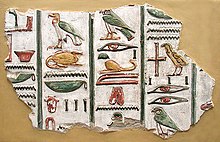
Back Egiptiese hiërogliewe Afrikaans Ägyptische Hieroglyphen ALS هيروغليفية مصرية Arabic هيروجليفى ARZ Xeroglíficos exipcios AST Misir heroqlif yazısı Azerbaijani Егіпецкія іерогліфы Byelorussian Египетски йероглиф Bulgarian मिस्र के हाइरोग्लिफ Bihari Hieroglif Mesir BJN
| Egyptian hieroglyphs | |
|---|---|
 | |
| Script type | usable as abjad |
Time period | c. 3250 BC – c. 400 AD |
| Direction | Right-to-left, left-to-right |
| Languages | Egyptian language |
| Related scripts | |
Parent systems | (Proto-writing)
|
Child systems | |
| ISO 15924 | |
| ISO 15924 | Egyp (050), Egyptian hieroglyphs |
| Unicode | |
Unicode alias | Egyptian Hieroglyphs |
| |
Egyptian hieroglyphs (/ˈhaɪrəˌɡlɪfs/, /ˈhaɪroʊˌɡlɪfs/)[1][2] were the formal writing system used in Ancient Egypt for writing the Egyptian language. Hieroglyphs combined logographic, syllabic and alphabetic elements, with more than 100 distinct characters.[3][4] Cursive hieroglyphs were used for religious literature on papyrus and wood. The later hieratic and demotic Egyptian scripts were derived from hieroglyphic writing, as was the Proto-Sinaitic script that later evolved into the Phoenician alphabet.[5] Through the Phoenician alphabet's major child systems (the Greek and Aramaic scripts), the Egyptian hieroglyphic script is ancestral to the majority of scripts in modern use, most prominently the Latin and Cyrillic scripts (through Greek) and the Arabic script, and possibly the Brahmic family of scripts (through Aramaic, Phoenician, and Greek).[not verified in body]
The use of hieroglyphic writing arose from proto-literate symbol systems in the Early Bronze Age, around the 33rd century BC (Naqada III),[6] with the first decipherable sentence written in the Egyptian language dating to the Second Dynasty (28th century BC). Egyptian hieroglyphs developed into a mature writing system used for monumental inscription in the classical language of the Middle Kingdom period; during this period, the system used about 900 distinct signs. The use of this writing system continued through the New Kingdom and Late Period, and on into the Persian and Ptolemaic periods. Late survivals of hieroglyphic use are found well into the Roman period, extending into the 4th century AD.[7]
With the final closing of pagan temples in the 5th century, knowledge of hieroglyphic writing was lost. Although attempts were made, the script remained undeciphered throughout the Middle Ages and the early modern period. The decipherment of hieroglyphic writing was finally accomplished in the 1820s by Jean-François Champollion, with the help of the Rosetta Stone.[8]
The number of words contained in all Ancient Egyptian (i.e. hieroglyphic and hieratic) texts known today is approximately 5 million, and tends towards 10 million if counting duplicates (such as the Book of the Dead and the Coffin Texts) separately. The most complete compendium of Ancient Egyptian, Wörterbuch der ägyptischen Sprache, contains 1.5–1.7 million words.[9][10]
- ^ Jones, Daniel (2003) [1917], Peter Roach; James Hartmann; Jane Setter (eds.), English Pronouncing Dictionary, Cambridge: Cambridge University Press, ISBN 978-3-12-539683-8
- ^ "hieroglyph". Merriam-Webster.com Dictionary.
- ^ There were about 1,000 graphemes in the Old Kingdom period, reduced to around 750 to 850 in the classical language of the Middle Kingdom, but inflated to the order of some 5,000 signs in the Ptolemaic period. Antonio Loprieno, Ancient Egyptian: A Linguistic Introduction (Cambridge: Cambridge UP, 1995), p. 12.
- ^ The standard inventory of characters used in Egyptology is Gardiner's sign list (1928–1953). A.H. Gardiner (1928), Catalogue of the Egyptian hieroglyphic printing type, from matrices owned and controlled by Dr. Alan Gardiner, "Additions to the new hieroglyphic fount (1928)", in The Journal of Egyptian Archaeology 15 (1929), p. 95; "Additions to the new hieroglyphic fount (1931)", in The Journal of Egyptian Archaeology 17 (1931), pp. 245–247; A.H. Gardiner, "Supplement to the catalogue of the Egyptian hieroglyphic printing type, showing acquisitions to December 1953" (1953). Unicode Egyptian Hieroglyphs as of version 5.2 (2009) assigned 1,070 Unicode characters.
- ^ Michael C. Howard (2012). Transnationalism in Ancient and Medieval Societies. P. 23.
- ^ Cite error: The named reference
Mattessichwas invoked but never defined (see the help page). - ^ Allen, James P. (2010). Middle Egyptian: An Introduction to the Language and Culture of Hieroglyphs. Cambridge University Press. p. 8. ISBN 978-1139486354.
- ^ Houston, Stephen; Baines, John; Cooper, Jerrold (July 2003). "Last Writing: Script Obsolescence in Egypt, Mesopotamia, and Mesoamerica". Comparative Studies in Society and History. 45 (3). doi:10.1017/s0010417503000227. ISSN 0010-4175. S2CID 145542213.
- ^ Carsten Peust, "Über ägyptische Lexikographie. 1: Zum Ptolemaic Lexikon von Penelope Wilson; 2: Versuch eines quantitativen Vergleichs der Textkorpora antiker Sprachen", in Lingua Aegyptia 7, 2000: 245–260: "Nach einer von W. F. Reineke in S. Grunert & L Hafemann (Hrsgg.), Textcorpus und Wörterbuch (Problemeder Ägyptologie 14), Leiden 1999, S.xiii veröffentlichten Schätzung W. Schenkels beträgt die Zahl der in allen heute bekannten ägyptischen (d.h. hieroglyphischen und hieratischen) Texten enthaltenen Wortformen annähernd 5 Millio nen und tendiert, wenn man die Fälle von Mehrfachüberlieferung u.a. des Toten buchs und der Sargtexte separat zählt, gegen 10 Millionen; das Berliner Zettelarchiv des Wörterbuchs der ägyptischen Sprache von A. Erman & H. Grapow (Wb), das sei nerzeit Vollständigkeit anstrebte, umfasst "nur" 1,7 Millionen (nach anderen Angaben: 1,5 Millionen) Zettel." (p.246)
- ^ W. Schenkel (1995). "Die Lexikographie des Altägyptisch-Koptischen". The lexicography of the Ancient Near Eastern languages (PDF). Verona: Essedue. p. 197. ISBN 88-85697-43-7. OCLC 34816015.
© MMXXIII Rich X Search. We shall prevail. All rights reserved. Rich X Search